A method tested personally earned over 1.8 million from 10,000 in just 11 months in 2024, nearly 180 times!
If you also want a piece of the pie in the coin circle, then take a few minutes to finish reading this article, and you are only one step away from a million!
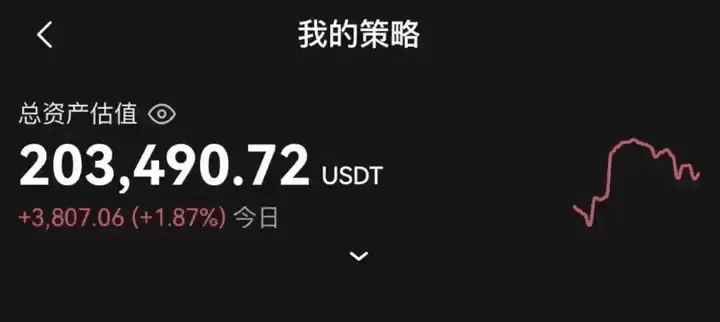
There are many common situations of retail investors being cut down like leeks. The following three are the most common.
1. Intraday fluctuations.
When a coin experiences intraday fluctuations, it is actually the main force taking advantage of retail investors. During the up and down fluctuations, if retail investors buy more, the price of the coin is likely to end with a significant drop. If retail investors panic and sell more, then after the fluctuations, the price of the coin is likely to rise instead.
2. Chase highs and cut losses
Chasing highs and cutting losses is also the most common emotion. Behind chasing highs and cutting losses is the fear of missing out and the fear of being trapped.
The emotion of chasing highs and cutting losses is also easily exploited by the main force. When more people chase highs, the main force often finds it easy to unload. In the morning, they might induce a lot of buying, and in the afternoon, they can crash the market for retail investors to see, causing those following the trend to lose more than 10% in a day. The main force just happens to take the opportunity to wash out retail investors, and it is not the coin price that should be chased or cut but the trend. Retail investors' partial understanding makes them the meal on the table for capital.
3. Negative and positive news.
Another point is that both negative and positive news will be exploited by the main force. Negative news can suppress coin prices, but it can also be interpreted as negative news being fully priced in, allowing the coin price to rise significantly. Similarly, positive news can push up coin prices or can be used to raise prices for selling.
Thus, how to interpret positive and negative news is determined by capital. How capital operates is actually based on market reactions and the actions of retail investors. When retail investors panic, capital greedily buys; when retail investors are greedy, capital immediately escapes. Using emotions to harvest retail investors is something that capital does very thoroughly and can be said to be done with ease.
Remember! Counteracting emotions is the only way for retail investors.

Starting from the trading strategy of the demigod in the coin circle, which earned 400 times in a year.
Bitcoin has surged, which has also brought some previous trading strategies to life. The simplest and most intuitive is probably this MACD trading strategy from the demigod of the coin circle, which claims to earn 400 times in a year.
In fact, it's simple; it’s just about finding opportunities for continuous MACD divergence.
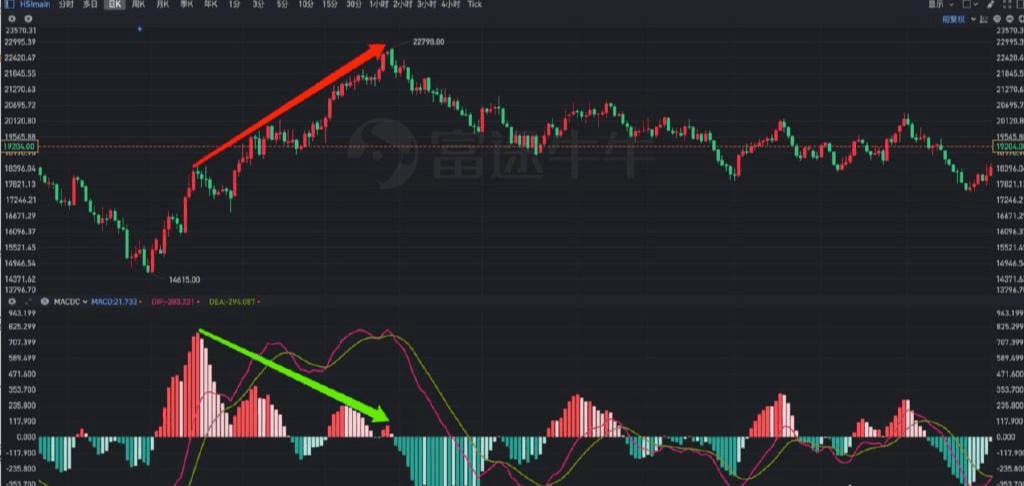
The above diagram is a good example that fully illustrates the two core points of this trading strategy: continuity and divergence.
How do we define continuity?
When MACD is above the zero axis, if a peak appears and does not drop below the zero axis before rising again, or if it drops below the zero axis and quickly crosses again to create another peak, this is what is called continuity.
How do we define divergence?
The peaks of the MACD are gradually decreasing while the stock price is gradually rising, indicating that the trend of the MACD is inconsistent with the trend of the stock price, which is called divergence.
Of course, inconsistent movements can be divided into two situations: when indicators fall but stock prices rise, it is considered top divergence; when indicators rise but stock prices fall, it is considered bottom divergence.
The above image is an example of top divergence; similarly, in the Hang Seng Index, bottom divergence had already appeared before the 924 market started.
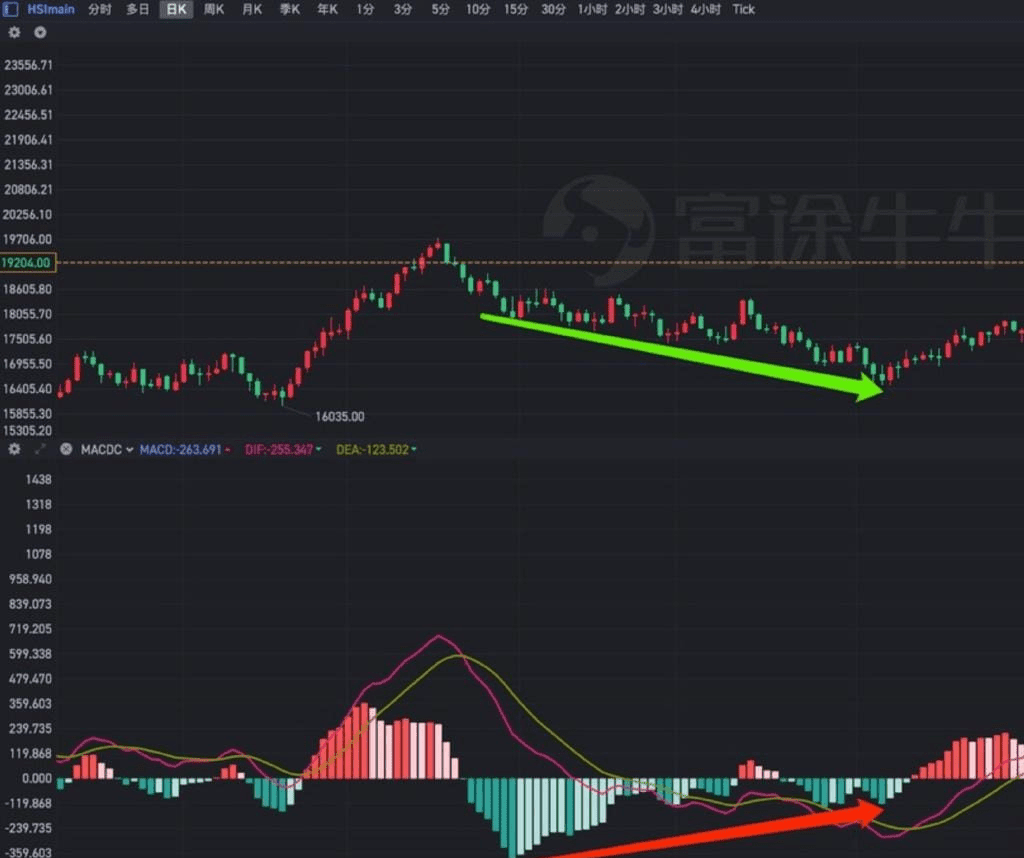
The demigod's trading strategy is to look for opportunities for consecutive divergences in the MACD indicator.
First, change the default parameters of MACD from 12 and 26 to 13 and 34, then look for consecutive divergences with significant differences in peaks and troughs, shorting on top divergences and going long on bottom divergences, with stop loss based on ATR with a parameter of 13.
Causes of divergence:
From the two screenshots above, it is indeed a great opportunity to short on top divergence and go long on bottom divergence. Everyone can also test this strategy on the targets they are interested in to see if it can capture some relatively large opportunities.
During this process, we may encounter two issues: first, the built-in MACD indicator only has fast and slow lines and histogram graphs, and does not include divergence recognition, making it very inconvenient to backtrack historical data to verify the effectiveness of divergence signals; second, after backtracking data, it is likely to find that divergence signals are quite effective, but bottom divergence is relatively more effective than top divergence.
How to solve the problem of recognizing divergence signals, we will discuss later. For now, let’s analyze the causes of divergence and why bottom divergence signals are more effective.
First, we need to look at the code of the MACD indicator and analyze the construction logic of this indicator.
1. DIF: EMA(C, 12) - EMA(C, 26), COLORRED; 2. DEA: EMA(DIF, 9), COLORGREEN; 3. MACD: (DIF - DEA) * 2, COLORSTICK;
That's right, the original MACD indicator is that simple; implementing the so-called 'king of technical indicators' MACD requires only three lines of code.
The first line calculates the difference between two moving averages of different time periods based on the closing price and displays it as a curve;
The second line calculates the average of the previous two moving averages' difference and displays it as a curve;
The third line takes the difference between the two and amplifies it, then displays it as a histogram.
So, even if we have not studied the design principles of the MACD indicator, we can analyze the causes of divergence just from its code.
If a top divergence occurs, meaning the peak of the MACD is decreasing while the stock price is rising and making new highs, this indicates that the value of the MACD is decreasing.
The value of MACD is derived from the difference between DIF and DEA, indicating that the gap between DIF and DEA is narrowing.
DEA is the average of DIF, which indicates that DIF is gradually decreasing or its increase is slowing. At the same time, due to the smoothing effect of DEA, when DIF's increase narrows, DEA is still rising, resulting in a decrease or even a reversal in the difference between the two.
The DIF is the difference between two moving averages of different periods. When the DIF gradually narrows or the increase slows, it means that the difference between the two moving averages is decreasing. The short-term moving average is sensitive, and the long-term moving average is smooth, so when the difference narrows, it can be seen as the slope of the short-term moving average beginning to approach the slope of the long-term moving average.
The slopes of the short-term and long-term moving averages are beginning to converge, which may be due to two reasons: the stock price has fallen or the increase has slowed. The condition for top divergence is that the stock price is still rising and making new highs, so the narrowing of the difference actually indicates that the increase is becoming smaller, meaning that it is in a state of stagnation and cannot rise further.
The same derivation process shows that the cause of bottom divergence is the occurrence of stagnation; it can’t fall further.
After a long period of fluctuations, once a trend forms, it is difficult to reverse. After top divergence occurs, some profit-taking funds may cash out, but those who did not believe at the beginning but are now just starting to believe are gradually entering the market. Although momentum has weakened, the trend is still there, and following a top divergence there may be another top divergence, causing the stock price to potentially form higher highs.
Similarly, after bottom divergence occurs, it is also possible to form lower lows. However, compared to rising, falling often occurs over a shorter time frame and with larger magnitudes, especially after several rounds of panic release when people become numb to negative news, having nothing left to fall; those remaining are mostly steadfast holders, coupled with the psychological advantage of buying low, often triggering a strong rebound, making bottom divergence signals easier to materialize.
Identifying divergence
If the stock price makes new highs while the indicator does not, it is considered top divergence, indicating a weakening of bullish trend strength, and the market may experience a top reversal; if the stock price makes new lows while the indicator does not, it is considered bottom divergence, indicating a weakening of bearish trend strength, and the market may experience a bottom reversal.
Since it is 'possible to reverse', it indicates a left-side trade. If it is still a contract trade, it is understandable why the demigod can achieve such high returns with this strategy.
Of course, since it is a left-side trade, it is possible to have occurrences of 'tops within tops, bottoms within bottoms, and divergence after divergence'. Therefore, the demigod's trading strategy also specially includes ATR-based stop losses to avoid the risk of trading contracts against the trend in strong trends, which could lead to total loss or liquidation.
There are both entry signals and stop loss rules; logically, this is a relatively complete trading strategy. The problem is that if you rely on the naked eye to identify continuous MACD divergences, efficiency will likely be very poor.
Although there are relevant indicators in TradingView for assisting trading, there are very few such toolbox-like indicator tools in domestic trading software. Most have flashy names that give the illusion that one can make money just by trading according to the indicator signals.
However, we all know that different markets, different targets, and different times require different treatments for the trading signals issued.
In a strongly trending market, the KDJ indicator may remain in the overbought or oversold range; in a fluctuating market, moving average indicators may repeatedly show golden crosses and dead crosses. If you rely entirely on a single signal, you may find you have lost everything after a period of time.
Therefore, technical indicators should be viewed more as auxiliary tools, and their function should primarily reflect improvements in efficiency. For example, if we can automatically recognize the pattern of continuous divergence in MACD through technical indicators, it can help us better seize such opportunities.
There are three key points for identifying divergence: triggering mechanisms, time range, and judgment methods. In previous articles, we introduced a simple way to identify divergence.
This identification method is very simple, using the golden cross and death cross of MACD as the triggering mechanism, using two golden cross/death cross events as the time range, and then judging whether divergence occurred based on the movement of DIF and stock price at the golden cross and death cross.
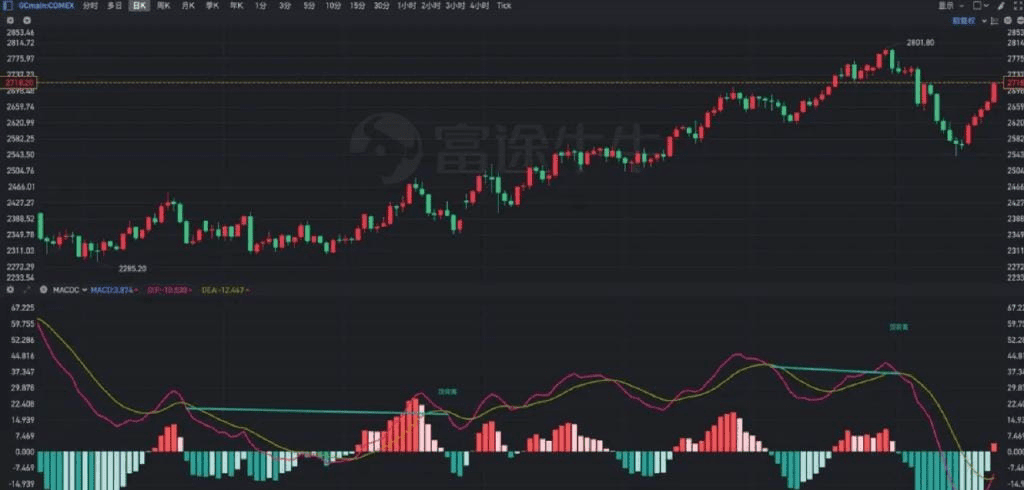
This actually belongs to a method of taking shortcuts. It can be used to look at things in general in ordinary circumstances, but it is clearly incorrect to rely on the demigod's trading strategy to identify signals.
For example, continuous top divergence refers to several gradually decreasing peaks in succession, with no retracement to below the zero axis between peaks or only a few bars dipping below the zero axis.
Therefore, its triggering mechanism must first find the peak, then look back to see the position of the previous peak, whether there is any part below the zero axis between the two peaks, and if so, check whether the number of bars below the zero axis exceeds the threshold. Finally, determine whether the two peaks are declining while the corresponding stock price is still rising.
Similarly, continuous bottom divergence must first show a trough, then look back to the previous trough to see if there is any part above the zero axis between the two troughs. If there is, we also need to check if the number of bars above the zero axis exceeds the threshold, and finally determine if the two troughs are rising while the stock price is still declining.
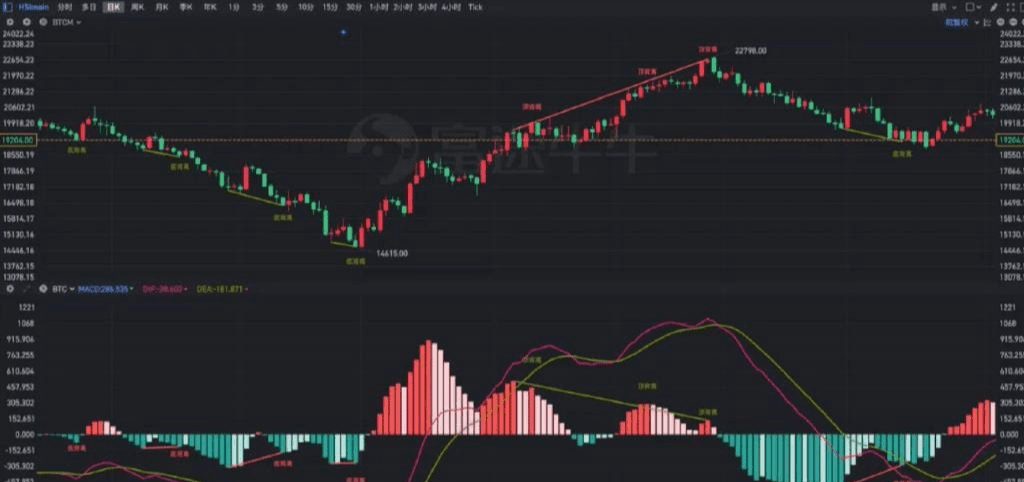
Comparing this to the screenshots given at the beginning of the article, we no longer need to manually draw lines to measure whether continuous divergence has occurred. By using custom technical indicators, we can identify whether MACD has diverged and connect the peaks and troughs. In the main chart, we can connect the highest or lowest prices corresponding to the peaks and troughs of the MACD, allowing for a clear identification of divergence.
Of course, since it is a custom indicator, the conditions for continuous divergence can be set according to personal preference, for example, whether two or three consecutive peaks and troughs should appear, the number of bars below the zero axis between peaks, and how significant the difference between consecutive peaks and troughs should be—all of these can be adjusted.
Identifying trends
The trading strategy based on divergence will enter the market when the trend has not yet fully confirmed, exhibiting the characteristics of left-side trading. Therefore, ATR-based stop loss is indispensable as an important component of the demigod's trading strategy.
However, we can certainly combine other technical indicators to further reduce the potential risks brought by left-side trading. MACD measures the strength of the trend, while the trend itself can naturally be measured using moving average indicators.
Generally speaking, most people identify trends based on the crossover of short-term and long-term moving averages. However, there is a major issue here: if the two time parameters are too close, the two moving averages may cross frequently, leading to a lot of ineffective signals. If the time parameters are too far apart, the timing for entering and exiting will be severely lagged.
Therefore, we can adopt a method like this: choose a personal preferred time parameter, then select different moving average algorithms to obtain the fast and slow lines.
For example, we first calculate MA10 using the closing price, then calculate EMA10 of MA10, thus mimicking the calculation principles of DIF and DEA to obtain two fast and slow lines, and then use the crossover of these two lines to formulate buy and sell signals.
Of course, this method has only one time parameter compared to traditional double moving averages, but it also inevitably has the issue of needing to filter out ineffective signals.
The market is mostly in a state of fluctuation, so we can use whether it is overbought or oversold as a filter for moving average crossover signals.
For example, when the double moving averages show a golden cross, if the RSI indicator is in the range of 50-70 (above 70 is considered severely overbought, do not chase high) and is rising, it is considered an effective buy signal; when the double moving averages show a dead cross, if the RSI indicator is in the range of 30-50 (below 30 is considered severely oversold, do not chase low) and is falling, it is considered an effective sell signal.
At the same time, further restrictions can be placed on K-lines, requiring the lowest price to be above the fast line when going long, and the highest price to be below the fast line when going short. This way, the effect shown in the image can be achieved.
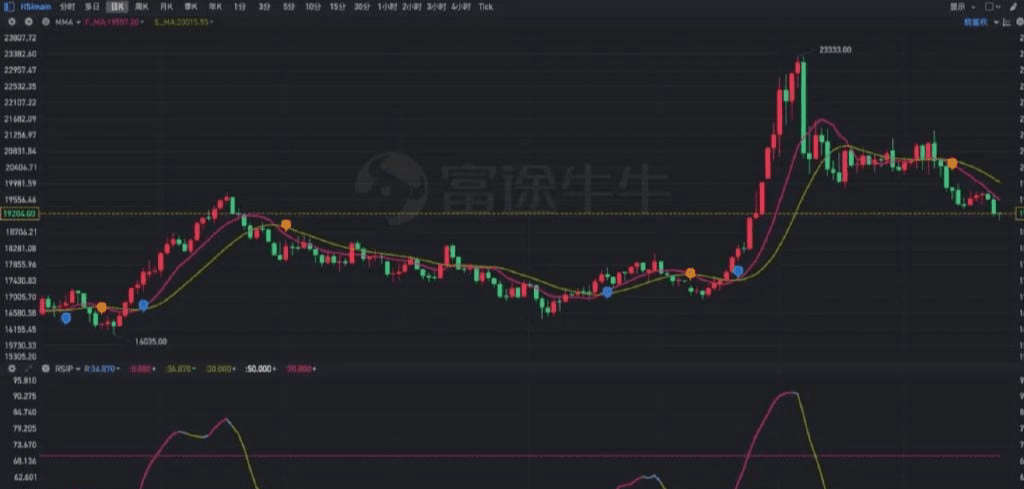
Optimizing and iterating
Thus, we have constructed a trading strategy using the basic technical indicators of moving averages, RSI/KDJ, and MACD.
For patient traders who can trade contracts, options, and futures and pursue a high win rate, they can patiently wait for the MACD continuous divergence signals to appear. Other traders can make short-term trades based on signals filtered by moving average crossovers and RSI.
Moreover, the beginning of a trend must trigger the crossover of the two moving averages, while the end of a trend often forms a MACD divergence.
Therefore, by combining them together, after making long and short trades based on moving average crossover signals, we can use divergence signals to observe when to take profits; after entering on the left side using divergence signals, we can then confirm on the right side through moving average crossover signals.
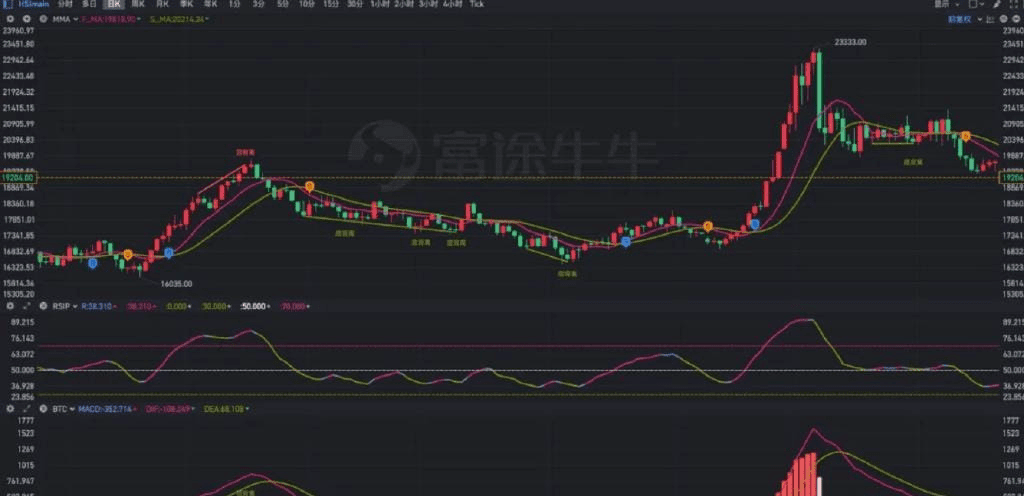
So, this is actually a complementary system, but there is still significant room for improvement in signal prioritization, compatibility between short and long-term, historical data backtesting, and parameter tuning.
Welcome all star friends to provide more feedback during the use of indicators, so that we can further optimize and iterate.
There is a saying that 'the most people lose money in a bull market.'
Thinking about it now makes sense. BTC keeps making new highs, why is that? Let's list some mistakes made by retail investors that lead to losses.
No research, blindly following trends to buy.
Holding too many positions with a small amount of capital.
Not understanding deeply after losses, failing to stop losses in time.
Choosing to lie flat after floating losses without continuously following up, providing feedback, and optimizing holding strategies.
In fact, as long as we continuously track—feedback—optimize, and consistently study and learn, it is possible to reduce losses and increase profits. A clear pattern is that when Bitcoin slightly falls (2-3%), altcoins generally plunge, and when Bitcoin slightly rises (3-5%), altcoins generally surge.
One thing that many beginners often forget is that at the same price level, a drop requires a larger increase to recover. For example, if you buy at 10 and drop 50% to 5, you need a 100% increase to break even.
#币安HODLer空投ERA #山寨季來了? #Strategy增持比特币
$SOL $ETH $BTC


